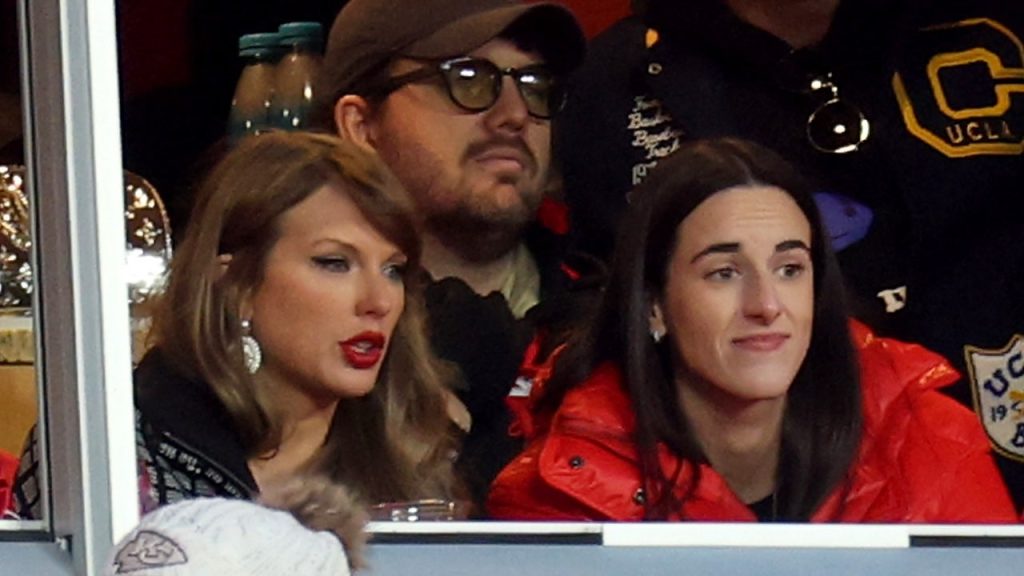The convergence of pop culture and sports fandom reached a fever pitch on Saturday when pop superstar Taylor Swift and WNBA phenom Caitlin Clark appeared together at a Kansas City Chiefs playoff game. While the pairing delighted many, it also reignited existing controversies and sparked new debates, primarily centered around Swift’s highly publicized relationship with Chiefs tight end Travis Kelce, Clark’s previous comments on white privilege, and the politicization of both figures. The unexpected appearance of Clark, a self-proclaimed lifelong Chiefs fan, alongside Swift in a stadium suite further fueled the ongoing conversation about the intersection of celebrity, sports, and political viewpoints.
The joint appearance was a culmination of a burgeoning friendship between Swift and Clark, initiated by Swift following a concert Clark attended during the singer’s Eras Tour. This connection, which also led to Clark featuring alongside Swift on the cover of Time magazine’s Inspiring Women special edition, solidified a public link between two prominent figures from different arenas, each carrying their own baggage of public perception and prior controversies. For some fans, this crossover represented a heartwarming display of mutual admiration and support between two successful women. For others, it amplified concerns about the increasing spotlight on Swift during Chiefs games and the perceived intrusion of political leanings into the sports viewing experience.
The presence of Swift at Chiefs games has been a recurring point of contention for some fans since she began publicly dating Kelce. Many have expressed annoyance at the frequent cutaways to Swift during broadcasts, arguing that it detracts from the game itself. The addition of Clark to the mix, a figure already embroiled in controversy stemming from her remarks on white privilege, exacerbated these sentiments. Some viewers saw the pairing as an unwelcome doubling down on the celebrity factor, further shifting focus away from the on-field action. This exemplifies the broader tension between the entertainment value of celebrity presence and the desire of some fans for a purely sports-focused broadcast.
Clark’s prior statement, “As a White person, there is privilege,” made during her Time magazine Athlete of the Year interview, remains a source of debate. While some lauded her acknowledgement of systemic advantages, others criticized it as virtue signaling or an unnecessary injection of political discourse into sports. This pre-existing controversy provided a backdrop against which her appearance with Swift was interpreted, with some viewers expressing disapproval of both figures and their perceived political affiliations. Specifically, Swift’s past endorsements of Democratic politicians like Kamala Harris became a focal point for criticism from those who felt her political views were being implicitly promoted through her high-profile appearances at Chiefs games.
The confluence of these factors – Swift’s relationship with Kelce, her perceived political leanings, Clark’s comments on white privilege, and the increasing media attention given to both figures during Chiefs games – created a complex and highly charged atmosphere surrounding their joint appearance. The event became a lightning rod for discussions about the role of celebrities in sports, the intersection of politics and entertainment, and the varying expectations and preferences of sports fans.
Ultimately, the reactions to the Swift-Clark appearance highlight the increasingly blurred lines between sports, entertainment, and politics in the modern media landscape. While some embrace the crossover and celebrate the visibility of prominent figures like Swift and Clark, others lament the perceived intrusion of non-sports elements into the game-day experience. This tension underscores the ongoing evolution of fan culture and the challenges of catering to diverse viewpoints in an increasingly polarized society. The debate over the presence and prominence of celebrities at sporting events is likely to continue as the worlds of entertainment and athletics become ever more intertwined.

